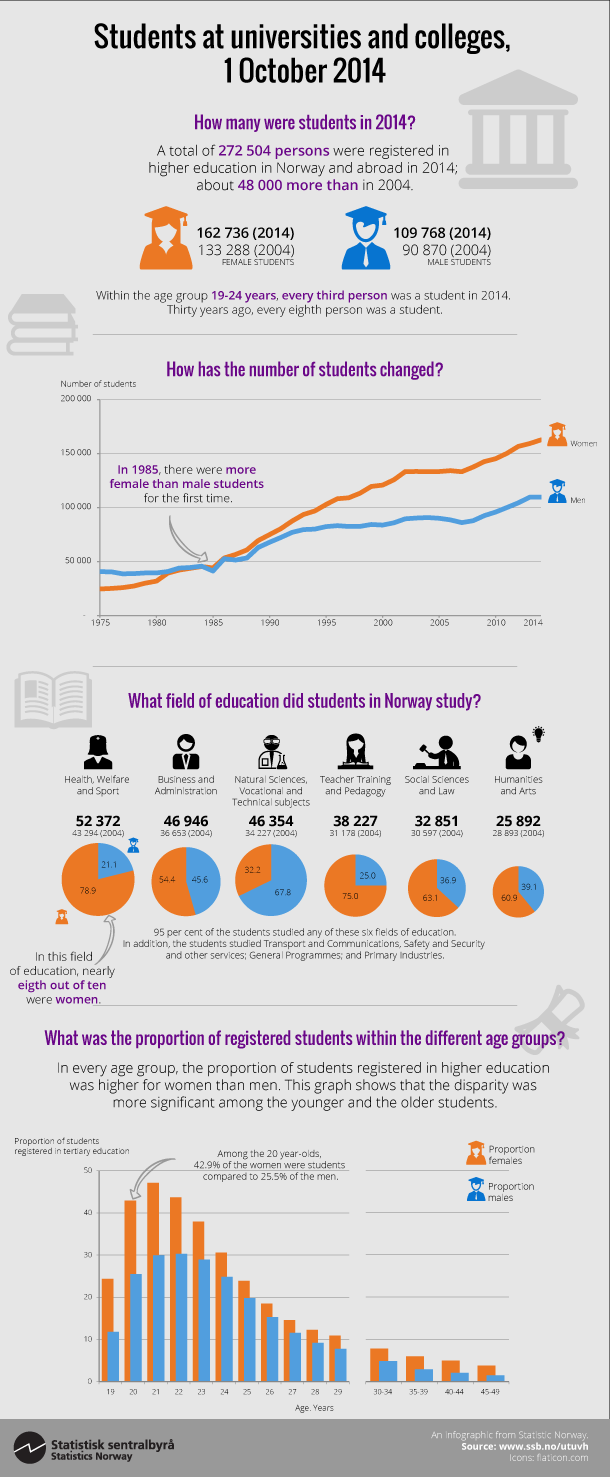Content
Published:
This is an archived release.
More women in higher education
A total of 272 500 students were enrolled in higher education in Norway or abroad in the academic year 2014/15; an increase of 3 400 students from the year before, with women accounting for the whole increase.
| 2014 | 2013 | 2004 | |
|---|---|---|---|
| Students in tertiary education | |||
| Total | 272 504 | 269 063 | 224 158 |
| Males | 109 768 | 109 700 | 90 870 |
| Females | 162 736 | 159 363 | 133 288 |
| Proportion 19-24 years in tertiary education | |||
| Total | 34.0 | 33.7 | 30.7 |
| Males | 27.1 | 27.5 | 25.1 |
| Females | 41.3 | 40.1 | 36.5 |
| Proportion 25-29 years in tertiary education | |||
| Total | 15.2 | 15.0 | 16.6 |
| Males | 13.5 | 13.3 | 15.4 |
| Females | 17.0 | 16.8 | 17.9 |
In 2014, 255 500 students were enrolled in Norwegian universities and colleges. Another 17 000 students were enrolled in universities and colleges abroad – a total of 272 500 students in higher education.
Almost 2 300 more students were enrolled in universities and colleges in Norway, and close to 1 200 more students were enrolled abroad. More students were in the age group 19-34 than the year before, and fewer students were aged 35 years and older.
More students = more women
About 110 000 male students and 162 500 female students were registered in higher education in 2014. Women accounted for the whole increase of 3 400 students in 2014 from the previous year. The number of men in higher education shows little or no change.
More younger students, fewer older students
More students in higher education were younger than 35 years and fewer students were 35 years and older in 2014, compared with the year before. In numbers, 4 500 more students were younger than 35 years and 1 100 fewer students were 35 years and older. About 700 more male students were younger than 35 years, but at the same time there were 700 fewer male students aged 35 years and older. Among female students, there was an increase of 3 800 students younger than 35 years and 400 fewer aged 35 years and older.
Fewer students studied abroad in Australia
More than 30 per cent of the 17 000 students abroad were enrolled in universities and colleges in the UK in 2014 – or close to 5 200 students. About 20 per cent of students abroad were in Denmark (3 000 students) and 10 per cent were studying in the USA (1 800 students). During the last decade, from 2004-2014, there was an increase in the number of students going to the UK – from 2 700 in 2004 to 5 200 in 2014. In the same period, the number of students studying in both Denmark and Poland rose by 1 000. Students studying at university and college level in Australia dropped in this period from 2 700 students in 2004 to less than 800 in 2014.
Pharmacy popular among students with an immigrant background
More than half the students studying for a Master of Pharmacy had an immigrant background in 2014 – the same as in 2013. About 33 per cent of 560 students in this master programme were immigrants and 19 per cent were Norwegian-born to immigrant parents. In the Master of Science programme, as many as 40 per cent of the 3 600 students were immigrants, while 2 per cent of the students were Norwegian-born to immigrant parents. The largest proportion of immigrant students was in Master of Philosophy – where 65 per cent of all students (140 students) were immigrants. In this programme the number of students enrolled was limited, and small changes will have a great impact on the proportion of immigrant students.
Contact
-
Geir Nygård
E-mail: geir.nygard@ssb.no
tel.: (+47) 48 15 13 44
-
Maj-Lisa Lervåg
E-mail: maj-lisa.lervag@ssb.no
tel.: (+47) 45 68 84 72

